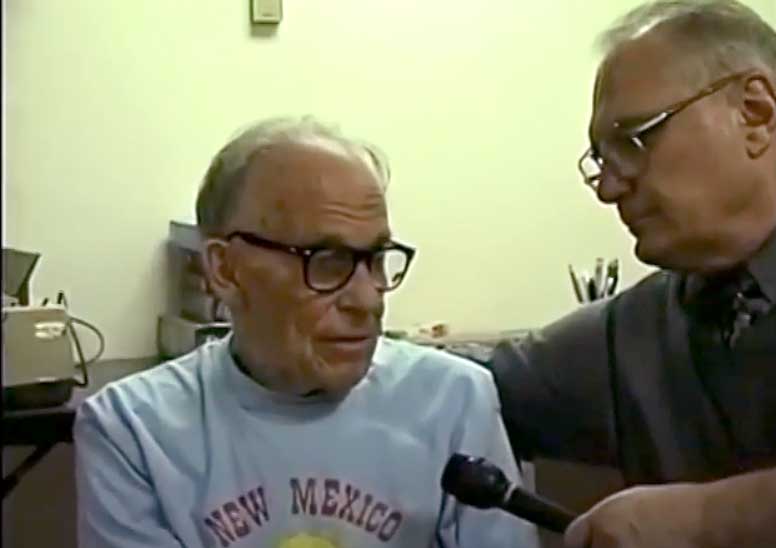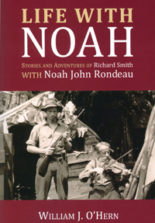This is a small portion of a lengthy interview recorded with Adolf “Ditt” Dittmar in 2001. Ditt photographed Noah John Rondeau.

Life with Noah: Stories and Adventures of Richard Smith with Noah John Rondeau
Ditt’s Camera
An interview with Adolf “Ditt” Ditmar regarding Noah John Rondeau.
Adirondack fold hero Noah John Rondeau was captured in dozens of photographs taken by
Adolph “Ditt” Ditmar in the late 1930s. Click on the photo to see a short except of an interview with Ditt.
Click here to see the full interview from 2001 done by Home Town Cable Network.
Adolph “Ditt” Dittmar was a young man when he first stepped foot into the Adirondack Mountains on a late summer day in 1938.
His name, appearing as “Courtesy Dr. Adolph G. Dittmar” credits the dentist for dozens upon dozens of snapshots of Noah John Rondeau, the hermit’s cabins, the surrounding vegetable and flower gardens and grounds of the hermitage atop Cold River buff that has had a way of capturing the attention of people who visited Rondeau’s Cold River “City” with its population of one as well as the images Ditt preserved on Kodak film that have a way of arresting readers of stories about the iconic Adirondack folk hero.
Yet, in spite of countless scenes the doctor has photographed there has been little information about the man who recorded history that has documented some great images seemingly ready to move or speak from a still-life scene.
The following story is a small portion drawn from a lengthy interview recorded at the Dittmar home in the 1990s. Ditt and his wife, Mary, and Mary’s sister, Helen C. Menz, were devoted early members of the Adirondack ’46-ers organization.
Noah was a patient of Dr. Dittmar. He has testified, “Dr. Ditt is the best dentist a hermit could ever have.”
Dr. Ditt also deserves credit for taking so many delightful snapshots of his most unforgettable Adirondack character. Ditt’s story begins.
I became acquainted with Noah John way back in 1938. I was employed as a counselor at a boys’ camp. We planned a canoe trip in the Adirondacks. We began our paddle to the Saranac lakes from Old Forge Pond. When we reached the point where the Cold River enters the Raquette River, Jack Sanderson mentioned he was familiar with the Cold River country and asked if I would care to cache the canoes and lead the boys inland to visit a hermit.
We were all enticed by the prospect of seeing Noah John. When we arrived at ‘Cold River City’ we unfortunately discovered that the ‘Mayor’ was not at home. A wood sign hung over the doorway to his cabin. It read “Ray Burmaster is an American Thief. He took away my Guide License.” Smoldering ashes in his cooking fire indicated that he had been there earlier that day. We sat around for a couple hours in the hope that the owner would return. It was a great disappointment when we finally had to leave before Noah returned.
However, at least I had learned about Noah and where he lived, and I knew how to get there. I was determined to return after the close of my summer employment.
In early fall, Bill Patterson and I decided to go on a post-camp trip. Several of Bill’s acquaintances completed the group. When we arrived at the city, Noah was home. He greeted us as we paraded under the ‘Gate to the City’ (a banner made from a large towel suspended above the path hand painted with those words).
Rondeau said he put the sign up to prove his place was a city. He wanted people to stop and see him. Just before you would enter the camp is where he had a towel or canvas sign, it changed from year to year, stretched across the trail about ten feet up.
He took us all around the city, pointing out the various buildings and whatnot. I remember he emphasized he had permission to live on the high bluff. When he pointed out the wigwams that he named he said, ‘Every time I come back to camp I bring back a couple of poles to add on.’ We talked about general subjects—mountain climbers and how many hikers had climbed to Couchee from his door step. One club, and in particular one member, he told about being in there earlier that year was Grace Hudowalski and the Forty-Sixers of Troy, the group she hiked with. He liked to talk about the mountains. The following year I made another trip back there. I spent almost a full week during which Noah offered me a challenge. If I would help carry a black ash tree trunk to camp he would show me the process, from start to finish, on how to make a split ash pack basket.
We first went to a swampy area to find and chop down a black ash tree about eight inches in diameter. Once it was down, we cut a section about seven feet long, then dragged it back to camp. The log would provide the ‘strips’ for weaving the pack-basket. We stripped off the bark, made parallel cuts down the length of the log about 3/4″ apart; then, he pounded the log with the back of a heavy axe while I used a sledge hammer to raise up the strips. It’s the annual growth rings that raise up and separate from the log that are used to weave pack baskets.
Not going further in the process of the basket construction, let me just state that the pack basket was completed, and as proof just look at one of the pictures. [He handed me several showing the process and the finished product.]
After I graduated from Columbus School of Dental & Oral Surgery, I applied for an internship at Albany Hospital. I wanted to be closer to the Adirondacks. My brother Charlie and I had several ascents of major Adirondack peaks. Somehow Grace Hudowalski had heard about it and had written to me. Soon after I got settled at Albany Hospital, I looked up Grace. Rondeau had said she was climbing the forty-six major peaks too. That’s how I heard of Grace. I was delighted to receive her letter. Not many people were climbing back then. I answered her immediately. She invited me to attend an Albany Chapter meeting of the Adirondack Mountain Club. I accepted. When I arrived at the meeting place, Grace introduced me to the ‘Colyer Twins,’ as Mary and Helen were called. The sisters weren’t twins. They were just close in age. It’s a meeting I will never forget. We remained in the hall and talked. We didn’t see much of the meeting.
The twins invited me to go on a hike that Saturday. Mary volunteered, ‘I’ll make you a lunch.’ I didn’t know it at the time, but this was the first of many, many lunches she would be making for me over the next sixty-plus years.
Anyway, to sum up my wandering tale about meeting Noah and the ‘twins,’ I have to tell you how all that I have told you has affected our lives. I will simply state that after three months of me exiting and entering via the fire escape, Mary and I were married in 1943. It might sound like a strange way to enjoy a honeymoon, but Mary elected to duplicate my 1938 canoe trip, including the miles-long hike up the Cold River trail to visit Noah.
We made many trips back to Noah John’s over the course of several years. A few were long stays, but there were many other short visits too.
Noah recorded Ditt’s arrivals and departures in his yearly diary.
September 2, 1941 Tuesday.
Perfect September sun. [At the] Old Lady’s Wigwam. 1 red squirrel shot.
1 bath. 1 hour after dark Dittmar & Patterson off Emmons [mountain].
The hermitage on Cold River bluff was “another world” Ditt said. “Noah had no dreams of living anywhere else. Sometimes on a warm night, when Mary and I are at our Silver Lake camp curled up on a blanket under a clear night sky we find ourselves talking about the stories and good times around his campfire.”
Mary and Ditt remembered Noah’s gleeful wisecracks each and every time they left his camp. “Yes, Noah John was quite a comedian,” Ditt concluded, “He always had to clown around as he sent us happily on our way with a canoe paddle to our behinds—which he never used.”
